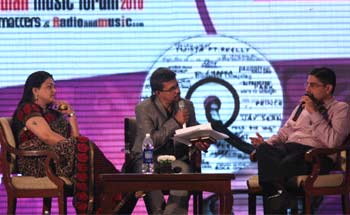MUMBAI: The contemporary â€?sound’ of Indian music stems from a complex amalgamation of Indian Classical, Regional, Bollywood, Indian Pop albums and rock
The first half of Nokia Music Connects Day Two had the regulatory heads, music label honchos, advertising gurus, corporate heads as well as top notch creative professionals from the music industry discussing on issues like piracy, copyright and the role of media.
After a break and a short session on live music, the next session explored the scope of regional music and other genres besides Bollywood.
South Indian singer and composer T S Ranganathan enthralled the audience with his 10-minute performance. This was followed by Indiantelevision.com Group founder Anil Wanvari’s tete-a-tete with actor Khushbu Sundar and Sun TV Network COO Ajay Vidyasagar. Khusbhu, brought in some lighter moments into the conference, when she talked about Illayaraja being her favourite composer and said that it was sad that singers and musicians do not get the same prominence as they used to earlier. A particular song is known as Khushbu’s song not this singer’s song,… she said.
Vidyasagar spoke about the fact that south Indian’s are big guzzlers of music, and the fact that there are the four major languages – Kannada, Tamil, Telugu and Malayalam. Our music channels or music shows have a greater share of audience viewing then do the music channels in Hindi nationally,… he pointed out. There are many platforms we have created on our channels in the form of singing reality shows which allows us to unearth new talent,… he pointed out.
He highlighted that the network is involved in print, television and movies. Right now there is no intent to launch a music label,… he said. Who knows about the future….
India is a vastly multilingual country. There are more than 22 languages which are being spoken by a majority of people in India. Bollywood is essentially based on the national language Hindi but music in other regional languages is an equally important component of Indian music.
A plethora of labels churn out devotional, classical and film music in Tamil, Telegu, Malayalam and Kannada. What are the high points of South Indian music business? What are the trends? What are its problems? Is there a potential for regional music to cross over to a national audience?
Panelists who came together to discuss regional music and other genres were Saregama’s Atul Churamani, South India Music Companies Association (SIMCA) joint secretary an one of the founders Rajesh Dhupad, Sony Music GM Ashok Parwani and Big FM senior VP- marketing Anand Chakravarthy.
Digital media and music consultant Mandar Thakur was the moderator for the session and gave the audience an insight into Indian regional music.
80% of Saregama catalogue consists of regional music recorded over a period of time. Most people might not believe but there is more affinity to buy traditional and regional music,… revealed Churamani.
But still many people prefer more of Bollywood music and this is the reason for physical CD sales of regional music not being what they can be. It’s easy to say â€?Think Global, Act Local’ but difficult to implement. Local companies have kept their costs low and hence they are able to sell local music. Regional markets can be best managed by regional players,… he added.
Dhupad was quite happy about regional music now being accepted as a major contributor to the music industry unlike earlier..
Besides the South Indian music industry, Punjabi music was also a part of the discussion. Punjab is an interesting market. It has a western influence over its Punjabi flavour and this has taken its regional talent on a national level. There are few Punjabi channels that promote popular Bhangra,… said Churamani appreciating Punjabi music
Being a Punjabi himself, Dhupad said that the western influenced-Punjabi pop music did not originate from Punjab but from the UK where a many young Britasians evolved a internationally influenced Bhangra movement in the nineties.
The dilemma is that the industry as well as audiences do not want to go beyond film music and hence sometimes regional music does not receive adequate support from TV channels and the media.
Not a single Tamil channel promotes non-film music. People forget that regional music needs to be treated at the grassroots level.60 per cent of the audience is ready to consume non-film music but it needs to gain popularity,… suggested Dhupad.
Saregama’s Churamani believes that language will always remain a barrier no matter what. India is a collection of states with people who speak 29 different languages but language is a big hurdle. There is no point playing Tamil music in Punjab or vice versa as people will not be interested in listening to it. Lyrics are a very important part of a track and it loses value when not understood well,… explained Churamani
Speaking about the contribution of FM stations in promoting regional music in the country, Chakravarthy said, Big FM stations in South have a pure regional flavour. Big FM was the first to go 100 per cent Kannada and we have got a great response. We have also started many award functions to motivate and encourage regional musicians, lyricists and singers. Tamil is a fore-runner in regional music and has exceptional cutting edge musicians. Hence we will be soon launching an award function for the Tamil music industry by November….
